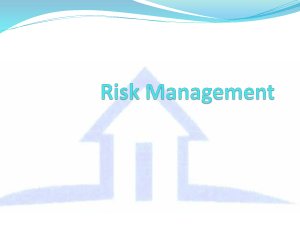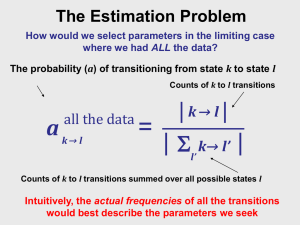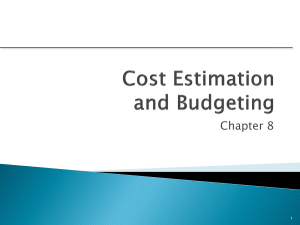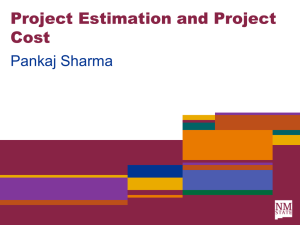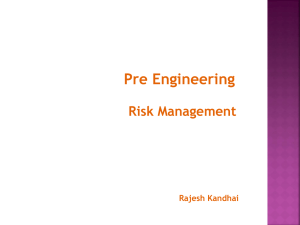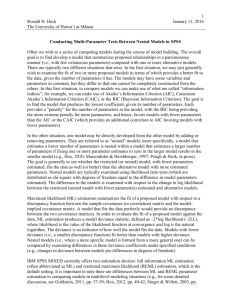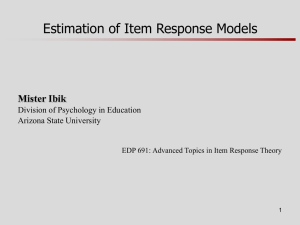Software Project Management
advertisement
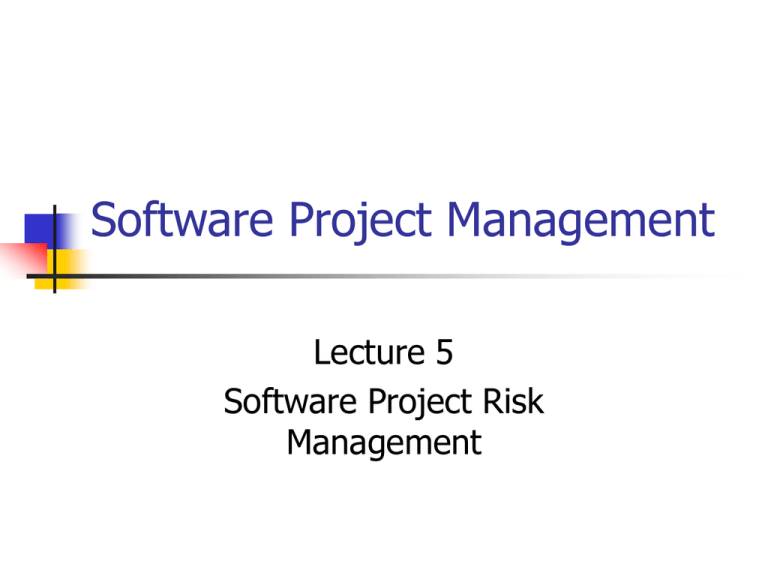
Software Project Management Lecture 5 Software Project Risk Management Overview Project risks Nature of risks Risk identification Risk estimation Risk evaluation Risk management Risk reduction strategies Software Project Management 2 Project Risks Factors that cause a project to be delayed or over-budget Software Project Management 3 Nature of Project Risks Planning assumptions Estimation errors Eventualities Software Project Management 4 Planning Assumptions Why assumptions Uncertainties in early stage of the project Software Project Management 5 Planning Assumptions (cont’d) Common assumption: “Everything will go smoothly” Environment is reliable and fixed Design will be perfect first time Coding will be ‘nearly perfect’ Software Project Management 6 Planning Assumptions (cont’d) Guidelines List all the assumptions Identify the effects of these assumptions on the project if they are no longer valid Software Project Management 7 Estimation Errors Difficult to have accurate size or time estimations Lack of experience of similar tasks Lack of historical data Nature of the task Software Project Management 8 Estimation Error (cont’d) Estimation can be improved by analyzing historic data for similar tasks and similar projects Keep historic data of your estimation and the actual performance Compare your estimation and the actual value Classify the tasks that are easy or difficult to give accurate estimation Software Project Management 9 Eventualities Unexpected and unimaginable events Common unexpected events Hardware cannot be delivered on time Requirements specification needs to be rewritten Staffing problem Software Project Management 10 Boehm’s Risk Engineering Risk Engineering Risk Analysis Risk Risk Risk Risk Identification Estimation Evaluation Planning Software Project Management Risk Management Risk Risk Risk Control Monitoring Directing Risk Staffing 11 Risk Identification Identify the hazards that might affect the duration or resource costs of the project Hazard Problem Risk A hazard is an event that might occur and will create a problem for the successful completion of the project, if it does occur Software Project Management 12 Hazard, Problem, and Risk Hazard: Mary’s baby may be born early Problem: Modules P and Q will have no coder Risk: Milestone 7 will be delayed, or extra budget will be needed to hire another coder Software Project Management 13 Risk Identification (cont’d) Type of risks Generic risk (common to all projects) Standard checklist can be modified based on the risk analysis of previous projects Specific risk (only applies to individual projects) More difficult to find Need to involve project team members Need an environment that encourages risk assessment Software Project Management 14 Risk Identification (cont’d) Guideline Use checklist that lists the potential hazards and their corresponding factors Maintain an updated checklist for future projects Software Project Management 15 Common Risk Factors Application factors Staff factors Project factors Hardware and software factors Software Project Management Changeover factors Supplier factors Environment factors Health and safety factors 16 Application Factors Nature of the application A data processing application or a lifecritical system (e.g. X-ray emission system) Expected size of the application The larger is the size, the higher is the chance of errors, communication problems and management problems Software Project Management 17 Staff Factors Experience and skills Appropriateness of experience Staff satisfaction Staff turn-over rates Software Project Management 18 Project Factors Project objectives: Ill defined Unclear to every team member and user Project methods: Ill specified methods Unstructured methods Software Project Management 19 Hardware and Software Factors New hardware Stability of the new hardware system Cross platform development Development platform is not the operation platform Does the language used support cross platform development? Software Project Management 20 Changeover Factors ‘All-in-one’ changeover Incremental or gradual changeover The new system is put into operation Adding new components to the system by phases Parallel changeover Both the existing system and the new system are used in parallel Software Project Management 21 Supplier Factors Late delivery of hardware Instability of hardware Late completion of building sites Software Project Management 22 Environment Factors Changes in environment such as hardware platforms Changes in government policies Changes in business rules Restructuring of organizations Software Project Management 23 Health and Safety Factors Health and safety of staff and environment Staff sickness, death, pregnancy etc. Any tragic accident to staff Software Project Management 24 Boehm’s Top Ten Risk Items Personnel shortfalls Unrealistic schedules and budgets Developing the wrong software functions Developing the wrong user interface Gold plating Software Project Management 25 Boehm’s Top Ten Risk Items (cont’d) Continuing stream of requirements changes Shortfalls in externally performed tasks Shortfalls in externally furnished components Real-time performance shortfalls Straining computer science capabilities Software Project Management 26 Risk Estimation Recall that Hazard Problem Risk Risk estimation is to assess the likelihood and impact of each hazard Risk exposure (risk value) It is the importance of the risk Risk exposure = risk likelihood × risk impact Software Project Management 27 Risk Estimation (cont’d) Risk likelihood The probability that a hazard is going to occur Risk impact The effect of the problem caused by the hazard Software Project Management 28 Risk Estimation (cont’d) Advantages The only way to compare or rank the risks To have a good quantitative estimate, the extra effort can provide a better understanding of the problem Disadvantages Estimation is difficult, subjective, timeconsuming and costly Software Project Management 29 Risk Estimation Techniques Risk likelihood Rank from Low, Medium to High Rank from 1 (least likely) to 10 (most likely) Risk Impact Rank from 1 to 10 Software Project Management 30 Risk Evaluation Ranking the risks Determining the corresponding risk reduction strategies Software Project Management 31 Ranking Risks Ranking the risks based on their risk exposures Ranking shows the order of importance In practice, also consider factors like Confidence of the risk assessment Compound risk The number of risks Cost of action Software Project Management 32 Risk Reduction Leverage (RRL) RRL is used to determine whether it is worthwhile to carry out the risk reduction plan. The higher is the RRL value, the more worthwhile is to carry out the risk reduction plan. RE before RE after RRL risk reduction cost Software Project Management 33 Risk Management Risk Risk Risk Risk Risk planning control monitoring directing staffing Software Project Management 34 Risk Planning Making contingency plans Where appropriate, adding these plans into the project’s overall task structure Software Project Management 35 Risk Control Minimizing and reacting to problems arising from risks throughout the project Software Project Management 36 Risk Monitoring It is an ongoing activity throughout the whole project to monitor the likelihood of a hazard; and the impact of the problem caused. Software Project Management 37 Risk Directing and Staffing These concerns with the day-to-day management of risk. Risk aversion strategies and problem solving strategies frequently involve the use of additional staff and this must be planned for and should be considered. Software Project Management 38 Risk Reduction Strategies 5 different types in a generic sense Hazard prevention Likelihood reduction Risk avoidance Risk transfer Contingency planning Distinctions among them are fuzzy Software Project Management 39 Hazard prevention Prevent a hazard from occurring or reduce its likelihood to an insignificant level Lack of skilled staff can be prevented by employing staff with appropriate skills Unclear requirements specification can be prevented by using formal specification techniques Software Project Management 40 Likelihood reduction Reduce the likelihood of an unavoidable risk by prior planning Late change to the requirements specification can be reduced by using prototyping Software Project Management 41 Risk avoidance Some hazards cannot be avoided but their risks may A project can be protected from the risk of overrunning the schedule by increasing duration estimates. Software Project Management 42 Risk transfer The impact of the risk can be transferred away from the project by contracting out or taking out insurance The risk of shortfalls in external supplied components can be transferred away by quality assurance procedures and certification, and contractual agreements. Software Project Management 43 Contingency planning Contingency plans are needed to reduce the impact of those risks that cannot be avoided The impact of any unplanned absence of programming staff can be minimized by using agency programmers Software Project Management 44 References Boehm, B. (1989) Tutorial on Software Risk Management, IEEE CS Press Hughes, B., and Cotterell, M. (1999) Software Project Management, 2nd edition, McGraw-Hill Pfleeger, S.L. (1998) Software Engineering: Theory and Practice, Prentice Hall Software Project Management 45
